What Are Export Templates?
Export Templates are essential tools for organizing, filtering, exporting, and sharing scan records. They let you control which criteria are used to filter your scan records and determine what details appear in your exported data. Follow this guide to create and customize Export Templates effortlessly.
How to Access Export Templates
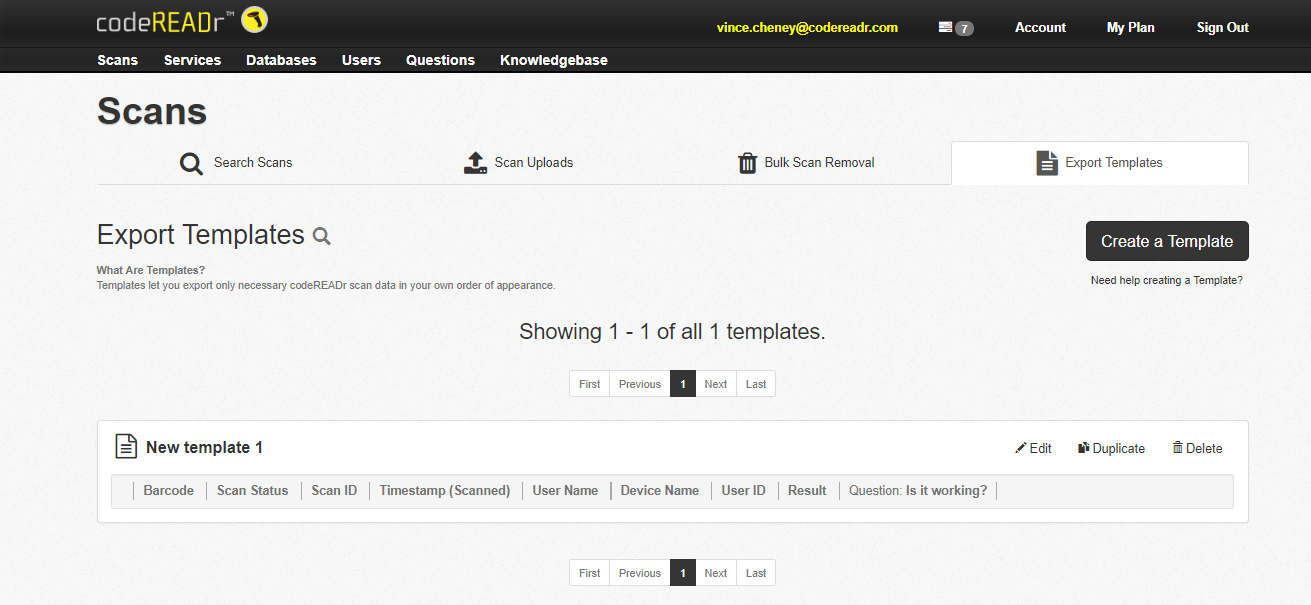
- Navigate to the Scans page.
- Select the Export Templates tab.
- Click Create a Template to get started.
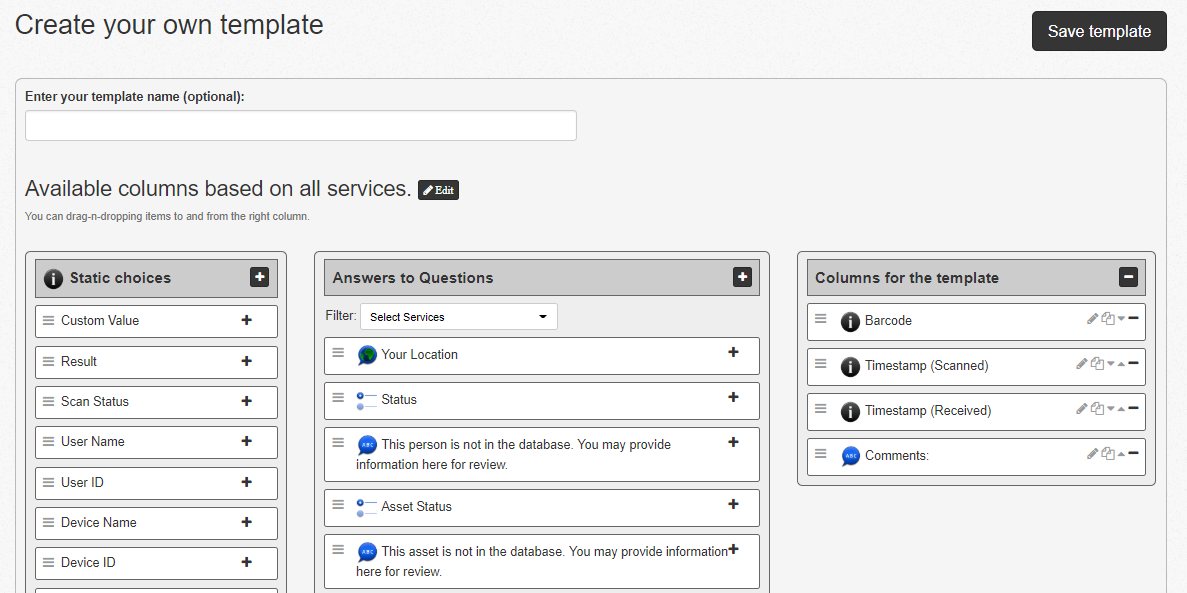
Creating an Export Template
Step 1: Customize Export Fields
On the template creation screen, you can:
- Select fields (values and questions) to include in your export.
- Arrange fields in descending order (the top field appears first).
- Filter questions by service to ensure you only include relevant questions (e.g., differentiate between similarly named fields like “Check In”).
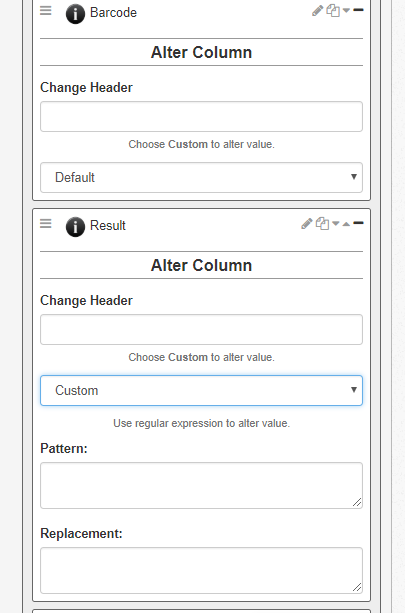
Step 2: Rename Columns
- Click the Edit icon next to a value to rename it for compatibility with your destination document.
- Use the Copy button to duplicate a value, enabling:
- Displaying multiple answers for a question in different columns.
- Repeating data across fields.
Step 3: Add Custom Columns
- Drag and drop Custom Value from the Static Choices section to create placeholder columns.
- Name the column and optionally autofill it with a static value.
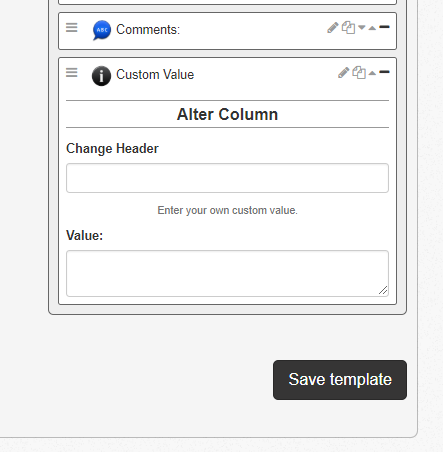
Advanced Options: Regular Expressions (Regex)
What is Regex
Regex lets you extract structured data from barcodes or raw response text, breaking it into separate fields for easier analysis. It’s commonly used for parsing formats like VCARDs or data with delimiters like tabs, spaces, or pipes.

Regular Expressions (regex) can break up raw data embedded together in a barcode (or in the response text) into individual fields. It is commonly used for VCARD parsing. Here are some examples.
Barcode including line feeds to parse into different lines
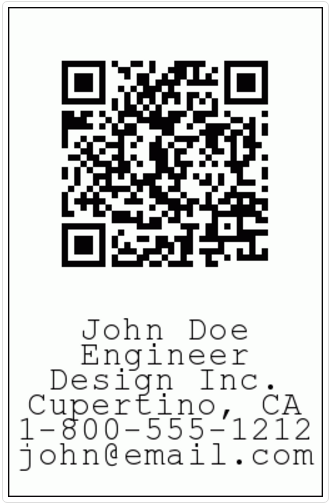
Pattern:
^([sS]*?)rn([sS]*?)rn([sS]*?)rn([sS]*?)rn([sS]*?)rn([sS]*?)$
Replacement:
$1 for Name
$2 for Occupation
$3 for Company
$4 for Location
$5 for Phone Number
$6 for Email
Result:
In each column:
John Doe
Engineer
Design Inc.
Cupertino, CA
1-800-555-1212
john@email.com
Notice the pattern begins with the ^ symbol and ends with the $ symbol. Also notice the ([sS]*?) pattern repeats six times for six elements. And (important) the rn repeats 5 times. You need to clone six times for six elements, each using the SAME pattern but with a different replacement ($1, $2, etc.).
Barcode including five 5 bar ‘|’ separators for 6 elements
Pattern:
^([sS]*)|([sS]*)|([sS]*)|([sS]*)|([sS]*)|([sS]*)$
Replacement:
$1 for Name
$2 for Occupation
$3 for Company
$4 for Location
$5 for Phone Number
$6 for Email
Input:
John Doe|Engineer|Design Inc.|Cupertino, CA|1-800-555-1212|john@email.com
Result:
In each column:
John Doe
Engineer
Design Inc.
Cupertino, CA
1-800-555-1212
john@email.com
Notice the pattern begins with the ^ symbol and ends with the $ symbol. Also notice the ([sS]*?) pattern repeats six times for six elements. And (important) the | symbols repeat 5 times. As with the line feed (rn) example, you need to clone six times for six elements, each using the SAME pattern but with a different replacement ($1, $2, etc.).
Barcode including five space separators for six elements
Pattern:
^([sS]*)s([sS]*)s([sS]*)s([sS]*)s([sS]*)s([sS]*)$
Replacement:
$1 for Name
$2 for Occupation
$3 for Company
$4 for Location
$5 for Phone Number
$6 for Email
Input:
John Doe Engineer Design Inc. Cupertino, CA 1-800-555-1212 john@email.com
Result:
In each column:
John Doe
Engineer
DesignInc.
Cupertino,CA
1-800-555-1212
john@email.com
Barcode including five tab separators for six elements
Pattern:
^([sS]*)t([sS]*)t([sS]*)t([sS]*)t([sS]*)t([sS]*)$
Replacement:
$1 for Name
$2 for Occupation
$3 for Company
$4 for Location
$5 for Phone Number
$6 for Email
Input:
John Doe Engineer Design Inc. Cupertino, CA 1-800-555-1212 john@email.com
Result:
In each column:
John Doe
Engineer
Design Inc.
Cupertino, CA
1-800-555-1212
john@email.com
Cloning fields and ordering elements based on element patterns
When using Batch Mode, for example, multiple barcodes are captured within a single field. If you need those barcodes to be presented in a certain order, regex can do that for you providing there’s a way to differentiate the barcodes values scanned. Please look here for an example regex for Batch Mode order.
Clone and parse elements in one field
Pattern:
^([sS]*?)||([sS]*?)||([sS]*?)||([sS]*?)||([sS]*?)||([sS]*?)$
Replacement:
$1 for Name
$2 for Occupation
$3 for Company
$4 for Location
$5 for Phone Number
$6 for Email
Input:
John Doe||Engineer||Design Inc.||Cupertino, CA||1-800-555-1212||john@email.com
Result:
In each column:
John Doe
Engineer
Design Inc.
Cupertino, CA
1-800-555-1212
john@email.com
VCARD barcode parsing
The parsing of VCARD data is similar to the above except you will need to parse each field based on the field’s description. Please look here for VCARD Parsing Regex for Barcode Scanner.
Batch Scanning
The CodeREADr app can quickly scan up to 500 barcodes in a single camera view. Here’s a blog article discussing batch scanning.
Parsing into Rows
When batch scans are exported, they will all appear in a single cell. Parsing each barcode into a separate row can currently only be done after the scan records have been exported. Contact support@codereadr.com for information on how to do that with Excel and Sheets.
Parsing into Columns
You can create separate columns when using an export template. You would clone the barcode field into separate columns and use the custom option to enter the regex based on the separator chosen for your batch scan.
Also, if select barcodes can be differentiated from the other barcodes recorded, a regex can be written to have them appear in specified columns. This PDF shows how to separate batch scans into separate columns.
Alternatively, if you have a large number of scan values in one cell, here’s a PDF showing how to parse them in Excel.
Special Fields in Export Templates
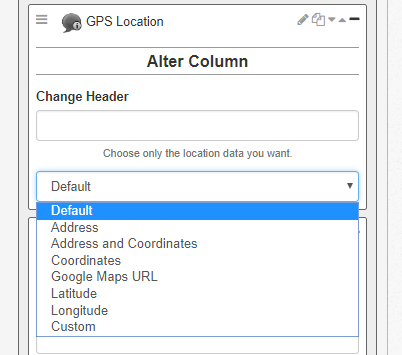
- GPS Data: Export GPS data in various formats, including:
- Address
- Latitude/Longitude
- Photos: Export links or filenames for photos collected via barcode scanning.
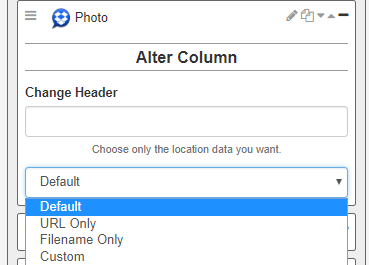
Using Formulas
For each column, you will see “Available options for altering value”, including:
- Default (no change).
- Custom (parsing, etc.)
- Formula (simple operators to add, subtract, concatenate, etc.).